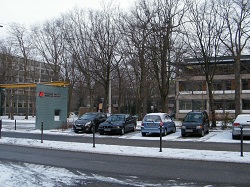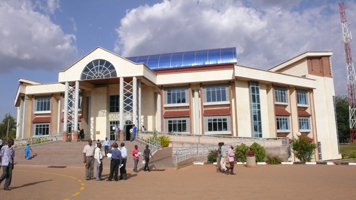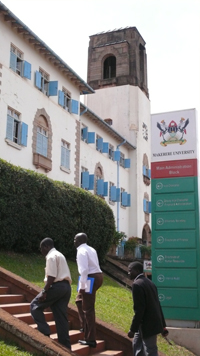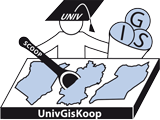The universities
In recognition of the requested regional approach in teaching, the two selected East African universities are either closely located to one of the forests that were studied within the BIOTA-East project or bear a scientific relation to them, while the German university has been the initiator of the unique geodata collection for these forest areas.
In recognition of the requested regional approach in teaching, the two selected East African universities are either closely located to one of the forests that were studied within the BIOTA-East project or bear a scientific relation to them, while the German university has been the initiator of the unique geodata collection for these forest areas.

Karlsruhe University of Applied Sciences HsKA is the largest institution (almost 7,000 students, more than 650 staff members) of its type in the German state of Baden-Württemberg. It has a long history dating back to 1878. In 1971 it attained its present status as a ‘Fachhochschule’. In contrast to the academic courses delivered in universities, courses are focused not only on academic learning but also on application-oriented project work to fulfil industry requirements. The Faculty of Geomatics is keen in networking with universities worldwide hoping to stimulate interest in its International Geomatics Masters’course. It believes in a particular strength regarding geomatics-related training for graduates from developing countries due to its experiences from previous (research) projects including strong capacity building components. Here in particular the strong commitment within the BIOTA East Africa project has to be pointed out which resulted in a vast network of partners from Kenya and Uganda.

Masinde Muliro University of Science and Technology (MMUST) is located in Kakamega Town in western part of Kenya. It was founded in 2002 initially as a constituent college, and later became the 7th fully-fledged Public University in Kenya in 2006. Presently the university has five academic faculties (Science, Engineering, Education and Social Sciences, Centre for Disaster Management and Humanitarian Assistance, and Health Sciences). Since establishment, the university has rapidly expanded and now hosts a student population of over 10,000, with approximately 350 full-time teaching staff, and about 1,100 non-teaching staff. As the only university in Kenya with a science park, it is in particular keen in promoting appropriate technology and research. The recently founded Centre for Kakamega Tropical Forest Studies (CEKATFOS) underlines the university’s commitment to its neighbouring environment. Although not having been an official BIOTA project counterpart, in 2009 MMUST and HsKA have sealed their collaboration with an MoU.

Makerere University (MAK) is one of Africa's oldest modern universities. It is located in Kampala, Uganda’s capital. MAK was founded in 1922, but only in 1970 it finally became an independent national university of the Republic of Uganda. Today 35,000 undergraduate and 5,000 postgraduate students from Uganda and abroad are registered in the study programmes. MAK is also a very active centre for research, thus aiming to maintain its status as one of the leading universities on the continent and beyond. Only recently Makerere was transformed into a Collegiate University with 8 colleges and 2 schools, operating semiautonomously. The university is extensively using Mabira Forest for the training of their students and is involved in managing the Budongo Conservation Field Station (BCFS) research station. Having been closely cooperating already within the BIOTA project, an MoU between MAK and HsKA was finally signed in 2011.
Motivation
- GIS is considered to be an integral part of present-time academic teaching, this also in developing countries.
- Assistance in filling modern curricula with life will provide the ground for an improved and extended academic training.
- We aim i) to build on capacities already available, ii) on experiences instead of inventing the wheel afresh, and iii) to benefit from activities running alongside.
- The triangular north-south-south network is of great value in regard to a more complete picture and understanding of development policy-related problems and towards harmonizing efforts between study programs of universities placed in the same wider region.
- The dialogue is driven by a lively exchange regarding knowledge and experiences between lecturers, assistants, graduates and students thus at the same time steering promotion for the up-and-coming scholars.
- The building of structures for a further qualification of the cooperating universities in the fields of teaching, research, as well as consulting and service will lead to an overall enhanced training situation.
- The prime aim is the establishing of a sustainable long-term institutional linkage having its innovative effect well beyond the partnership plus contributing to intercultural understanding and dialogue across the ‘development divide’.
Activities to build on
The partnership is based on already well established contacts of the HsKA to Kenya and Uganda. The reason is the BMBF-funded interdisciplinary biodiversity project BIOTA East Africa. With a funding from 2001 to 2010 we can build on more than 9 years of joint cooperation and research in the area. With HsKA (subproject E02) having been responsible for all GIS and remote sensing activities in particular for the wider Kakamega Forest area (Kenya) as well as for Budongo and Mabira Forest areas (Uganda), we not only know the area very well but have established an astonishing pool of geospatial data, printed the BIOTA East Africa Atlas, and developed various geospatial data-related Tools. The close cooperation with stakeholders, in particular in the last phase of BIOTA, resulted from an active involvement in participatory forest management planning, aiming at the actual use of the data in on-ground management. Here, the setting-up of a Biodiversity Information Centre (BIC) in Kakamega Town, hosting a GIS unit, was one of the major exit strategies. BIOTA-East has in particular become known for its strong capacity building component, with E02 having run in-country GIS courses for members of counterpart institutions plus training and supervision of Masters’ (2 years International Geomatics course at HsKA; KAAD funded) and PhD students (in-country). The many efforts and activities plus having on and off time spent in Kenya and Uganda has led to a wide and strong network of stakeholders we have cooperated with (in Nairobi and western Kenya KWS, KFS, NMK, MMUST, and KEEP being the most relevant, in Ugandan NFA, UWA , MAK, and MAFICO) as well as friendships.
The partnership is based on already well established contacts of the HsKA to Kenya and Uganda. The reason is the BMBF-funded interdisciplinary biodiversity project BIOTA East Africa. With a funding from 2001 to 2010 we can build on more than 9 years of joint cooperation and research in the area. With HsKA (subproject E02) having been responsible for all GIS and remote sensing activities in particular for the wider Kakamega Forest area (Kenya) as well as for Budongo and Mabira Forest areas (Uganda), we not only know the area very well but have established an astonishing pool of geospatial data, printed the BIOTA East Africa Atlas, and developed various geospatial data-related Tools. The close cooperation with stakeholders, in particular in the last phase of BIOTA, resulted from an active involvement in participatory forest management planning, aiming at the actual use of the data in on-ground management. Here, the setting-up of a Biodiversity Information Centre (BIC) in Kakamega Town, hosting a GIS unit, was one of the major exit strategies. BIOTA-East has in particular become known for its strong capacity building component, with E02 having run in-country GIS courses for members of counterpart institutions plus training and supervision of Masters’ (2 years International Geomatics course at HsKA; KAAD funded) and PhD students (in-country). The many efforts and activities plus having on and off time spent in Kenya and Uganda has led to a wide and strong network of stakeholders we have cooperated with (in Nairobi and western Kenya KWS, KFS, NMK, MMUST, and KEEP being the most relevant, in Ugandan NFA, UWA , MAK, and MAFICO) as well as friendships.
Furthermore we can build on project experience of specifically targeting the establishment of GIS labs as well as training the dedicated university staff members in a developing country. From 2005 to 2006 the Faculty of Geomatics of HsKA got involved in the EC-funded Asia IT&C project GeoTeach CensoPhil. Here, we supported the building of two GIS centres at universities in the central (University of Saint La Salle, Bacolod) and southern Philippines (Xavier University, Cagayan de Oro) with our main contribution of intensive preparing four Philippine staff members for their job of running the GIS labs plus teaching students, lecturers and externals back home. Major outputs were the two new GIS-labs, a research thesis per candidate, GIS-module materials and plans for wide-spread curriculum integration. With the experiences made in participative curriculum development during that intensive time of capacity building, a thorough ground is provided to transfer the approach to other developing countries including a realistic judgement on what is needed and feasible under the means provided.
Discussions between HsKA and MMUST on enhancing their GIS teaching capabilities started already as early as 2006. Due to the university’s continuous expansion going along with a severe lack of space, it is only now that GIS lab facilities are close to being available. MAK ever envied BIOTA’s stronger commitment in Kenya; this is particular regarding the setting-up of GIS facilities at the BIC in Kakamega plus the offering of GIS training. Makerere University has a long history of GIS training in currently three GIS labs and GIS software since the 1990s. University members agreed that bringing together of resources would be highly beneficial.
Karlsruhe, 23/04/2012






